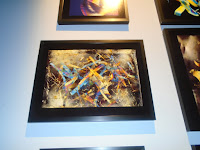The title of the exhibit that I visited was, Chemical Light, by Victor Shanchuck.
This exhibition was made up of a collection of liquid-like observational figure drawings from the 1970s that were made using photographic chemicals instead of classic drawing materials.
The lighting was dim and was directed only at the drawing themselves. The space was kept rather dark in order to support a slide show that was being projected on two opposite walls. The walls were painted a neutral gray and gave off a sort of mysterious or even "spooky" vibe, in my opinion. There were some leather chairs placed in the center of the room but the seating was very limited. There were two entrances into the exhibit space which was more enclosed than some of the others at Burchfield Penny.The viewer's attention is led from the projections of the art on two of the walls to the actual pictures on the other two walls. The sound of the projector makes us aware of the projections and gives off a mechanical feel at this exhibit. One wall had several larger pictures lined up in a straight row, while the other had more of of a grid of several smaller pieces of art. The pieces themselves were all very similar and abstract. The colors and specific shapes of the designs varied and the use of very vivid and varied colors made the art really stand out among the drab background. Each picture was framed very simply in a black square frame which actually barely showed since the background of the pictures are all black. The pictures were not individually titled and labeled. They are all part of one work of art.
 |
| This piece is one of the smaller pieces that was part of a larger display of pieces. It uses complimentary colors of blue and orange which make it very appealing to me. |
This next piece uses a variety of color and uses line to create a beautiful effect. In my opinion, this piece looks like a beautiful gift wrapped present. The artist uses the entire space for this piece.
I enjoyed the different use of space in this work. It is not symmetrical yet it still uses the whole space. This piece seems to show the very abstract nature of this type of art.
It was a very different experience to visit a gallery to specifically study the creation of the different exhibitions. I think it was very interesting to see how the artists use of a specific space can effect the viewers experience and even their enjoyment of the art itself. I never realized that things such ass wall color and placement of seating etc was so intentional until now. This exhibit that I studied, Chemical Light, would not be my personal preference due to the modern and abstract designs. I can appreciate the overall vibe that the artist was trying to communicate with his exhibit design though and I learned a lot from this gallery visit.










